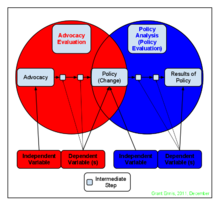Advocacy evaluation
Advocacy evaluation is different from policy analysis, which generally looks at the results of the policy, or mainstream program evaluation, which assesses whether programs or direct services have been successful.
In order to evaluate something, one must know the goals of the program/activity, in this case - advocacy efforts.
Policy advocacy evaluators look at these dependent variables (many of which interrelate significantly with movement in the policy cycle): Intermediate Goal Examples: Ultimate Goals Direct Advocacy (Directly trying to influence policy makers): Indirect Advocacy (Indirectly influencing policymakers by getting their constituents to advocate): Advocacy evaluation: Contribution Analysis: Note – some of the following evaluations should be seen as forms of "Proto" Advocacy Evaluation, done prior to, or without regard for, current best practices in this field.
Many simultaneously conduct policy analysis and advocacy evaluation.
Most are, at the least, useful examples for anyone wishing to conduct Advocacy Evaluation.
